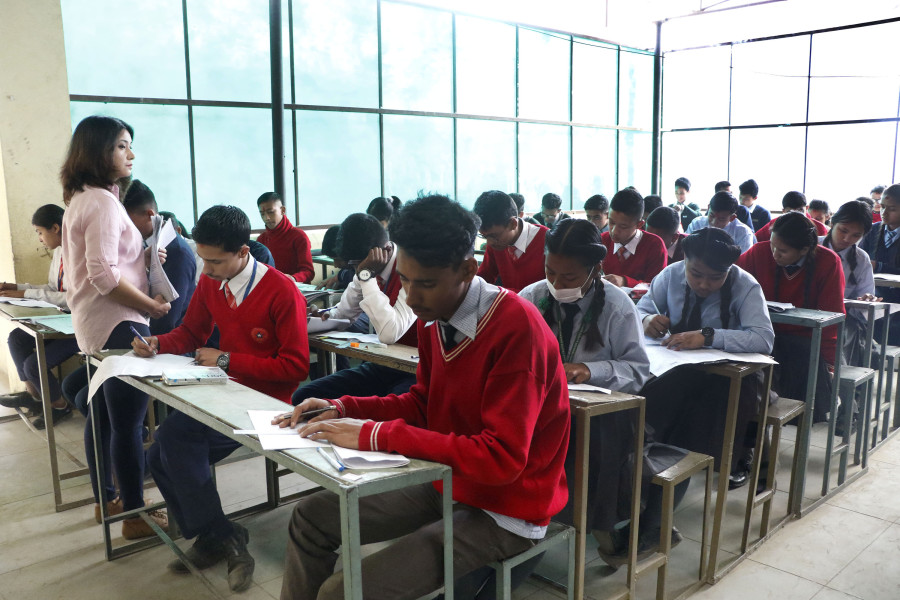Columns
Problems with large class sizes in elementary and secondary schools
Large class size is a learning and social justice issue that has often been overlooked.
Thomas (Tom) Robertson
One of the biggest—but least commented upon—problems with Nepal's education system is the problem of large class size. In the US—where roughly 90 percent attend a public school system that has, despite significant problems, forged opportunity and upward mobility for decades—a high school class with 30 students or more would be a large class. A class of 40 would be very rare, more than 40 unheard of. Here in Nepal, classes of 50 or 60 are as common as dal bhat tarkari, and over 80 or 100 not unusual.
I saw the problems of large classes firsthand at a secondary school in Khotang where I taught as a Peace Corps volunteer in the 1990s. In my school, class 6 and 7 had 60-70 students and classes 9 and 10 over 100 each. Teachers made heroic efforts to reach students but faced an uphill battle.
Large class sizes make real learning next to impossible. Teacher-centred rote methods become almost inevitable. With so many students, what else can even a motivated teacher do besides lecture? Even the simplest tasks—taking attendance or handing out papers—become nightmares. Physical space is also a problem; teachers often can't even walk around. Students can have trouble seeing the blackboard and even hearing the teacher.
With large classes, giving individual attention—and even learning student names—is too difficult. So are tests, which are so challenging to organise that they can happen only once or twice a year (as opposed to every week or two in other countries). The cumulative effect on student learning is devastating.
In a recent article, Dr Laxman Gnawali studied why so few Nepali teachers implement new methods from trainings. He found that trainings are often designed for ideal classroom settings with few students. Back in their regular schools, in classes of 60 or more students, even highly motivated teachers find it impossible to implement new methods.
In a recent online journal, Binod Singh Dhami summed up the training problem like this:
‘I have attended some teachers' trainings in which facilitators of the training keep saying individual attention, facilitation, individual monitoring are very essential elements.’ But big classes make such innovative teaching not just difficult but ‘impossible’.
Large classes cause other problems in addition to rote methods, such as student misbehaviour and cheating (the problem few want to discuss, much less address).
Like the abysmal quality of government schools more generally, large class size is a social justice issue. Who is most likely to be sitting on the crowded benches of those classes of 60, 70 or 80? It's usually Nepal's poorest students, ethnic minorities, and dalits—those already disadvantaged and underprepared. Is it any wonder such students fall behind and drop out?
Schools in the mid-hills sometimes have huge class sizes, but the problem is particularly acute in schools in the Tarai. Tarai districts have some of Nepal's most economically disadvantaged children and large percentages of Dalit and indigenous Tharu children.
The highest student to teacher ratio in government schools in Nepal is in Province 2 (eastern Tarai) at 59:1. The next highest is Province 5 (western Tarai) at 38:1. The national average for government schools is 33:1 at the primary level, 60:1 at the lower secondary level, and 40:1 at the secondary level. But these statistics make the situation look better than it actually is. The government determines student to teacher ratios based on the number of teachers per school. That's different than average class size, which is likely to be much higher because not every teacher teaches every period. Thus, in the eastern Tarai, in reality, the actual average class has far more than 59 students.
More helpful than a student to teacher ratio would be actual class size data and grade-by-grade data (not school type by school type). Better numbers would yield a more fine-grained analysis. And even more helpful would be demographic and outcome data from the largest of the large classes. Those interested in social justice in Nepal should insist on this.
In addition, we know very little about what teaching and management strategies work in large-sized classes in Nepal. Very little research exists. Thus, we don't actually know what methods work with large-sized classes in other developing-world countries and whether they could yield results in Nepal. It's also likely that some enterprising, creative Nepali teachers have devised innovative methods for teaching large classes. Let's collect and share those ideas.
Reducing the size of the largest classes may not actually be that hard to accomplish. Unlike tricky social problems like discrimination, it's often a straightforward economic matter. Money is never easy to come by, but it's not impossible either. Moreover, the problem is often as much administrative as financial. Some schools have far more teachers than they need; they could be transferred where students need them. But alas, that becomes a political problem, as powerful teachers resist transfer.
Large class size is a big problem, but not necessarily an unsolvable one. And solving it, or at least collecting more data and studying the situation better, could make a big difference, especially for some of Nepal's most disadvantaged and at-risk children.
Doing so would help Nepal's government schools move toward becoming the engines of opportunity that they should be.
***
What do you think?
Dear reader, we’d like to hear from you. We regularly publish letters to the editor on contemporary issues or direct responses to something the Post has recently published. Please send your letters to [email protected] with "Letter to the Editor" in the subject line. Please include your name, location, and a contact address so one of our editors can reach out to you.




 11.12°C Kathmandu
11.12°C Kathmandu















